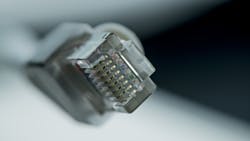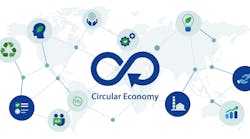About five years ago, LEDs Magazine saw a wave of developments in smart technology partnerships and connected lighting projects as the term “Digital Ceiling” began to take the tech world by storm. Leading that charge were information technology (IT) providers such as Cisco, who appeared to recognize the prospects for enhanced building networks by engaging the ubiquitous lighting hardware. The IT systems giant developed a partnership program with key solid-state lighting (SSL), automation, and controls providers heavily involved in the initiative. The Digital Ceiling moniker was heavy in the rotation of LEDs coverage through 2015 and 2016, with various collaborative projects from large-scale commercial real estate to a data center, where installation, maintenance, and energy savings attributed to PoE were the big news. The prospects for PoE seemed wide-ranging, but announcements began to trickle within the following 18 months to two years.
Alongside the wave of interest in PoE, the propagation of multiple wireless protocols for smart lighting began to take center stage in the lighting supply chain, with the promise of various methods and topologies to take full advantage of the digital control capabilities of LED-based SSL — from Wi-Fi to Bluetooth to Zigbee and more. Unfortunately, uncertainty over which protocols would remain in play has been further confused by a number of proprietary connectivity technologies coming onto the market. Several years passed with the key question in discussions becoming “Which standard will win for connected SSL?” While no definitive answer has resulted, we’ve heard calls from stakeholders across the industry to focus on interoperable standards and open application programming interfaces (APIs) in order to execute successful smart technology strategies for the evolving SSL business.
Now, we must digress for a moment. Some portion of our audience will likely comment that connected and smart lighting are not necessarily one and the same. We’d concede you are correct and ask you to simply assume for the purposes of this article that we are talking about connecting the lighting and all associated networked devices with PoE, controls, and management systems for the purpose of delivering smart functionality such as data collection, occupant behavioral and building operations analytics, and more. Therefore, the terms “connected” and “smart” will be used interchangeably here.
Carrying on, after some internal discussion in the summer of 2019 about the quiet time in between PoE lighting news, we published a blog questioning whether the potential of PoE has dwindled or has already matured to the point where it’s assumed to be pervasive in lighting projects. It turned out that the answer was not so clear cut; when we began to examine our assumptions more closely and look toward the experts in our audience for feedback, many of them had plenty to say about the advantages and disadvantages of PoE for lighting, and what role the technology stands to play in the market and the execution of smart systems and Internet of Things (IoT) roll-outs yet to come.
SURVEY SAYS
Survey speaks to PoE pursuits
In a recent State of the Industry survey to our audience to get perspectives on various LED and SSL technologies, applications, and opportunities, nearly 33% of participants indicated that they had worked with PoE to power luminaires. And in a forward-looking question, nearly one-third of survey respondents said they foresee PoE replacing legacy AC/DC technology as a power supply or driver technology — amongst other options that included AC-LED technologies, other DC grid technologies, and a small segment who responded with “Other” options such as lithium battery technologies and non-electrolytic AC/DC drivers.
Putting the ‘power’ in PoE
The basic value proposition of PoE is the ability to both transmit data and distribute DC power over less-expensive Category (Cat)5/Cat6 Ethernet cable instead of from the conventional AC mains grid (Fig. 1). The initial drive by the networking community in developing an extension to traditional Ethernet was to power remote network devices with low-voltage needs.
The IEEE 802.3af standard specified more than 15W of power available to devices; later on, the 802.3at PoE+ specification made 30W available to end devices, which was plenty for many SSL end products available several years back. The PoE switch is the power supply to devices in the network architecture, so its power per port plays a critical role in the capacity of a PoE-based system (Fig. 2). Fast-forward to more recent days and the IEEE has released 802.3bt-2018 (Fig. 3), which uses all four pairs of a PoE cable rather than the two pairs of a four-pair cable set out in previous standards. This enables power outputs of up to 90W per port depending on the type and classification of the device, as explained by Navigant senior research analyst Krystal Maxwell in a recent feature on the opportunities for PoE to penetrate smart buildings.
The push to increased power loads has generated wider interest, according to some of our readers. Network architect Tim Kraft of Zones, Inc., a hardware, software, and IT business solutions provider based in Clifton Park, NY, said, “PoE lighting in new construction is, in my opinion, still evolving. Prior to 802.3bt or 90W Type 4 PoE, it was just a wireless access point (WAP)-powering device. There was not a lot of incentive to do anything else. Now with more power comes more opportunities.” He continued, “Cisco, Intel, and IoT are pushing end-user awareness. New York State and New York City have incentives to move to LED lighting and occupant-centric energy conservation. That puts PoE and LED front and center.”
Indeed, Maxwell cited the latest PoE standards as one of the factors propelling the aforementioned Navigant forecast for the use of PoE in digitally-equipped commercial buildings, with a potential revenue of $352.9M (million) by the end of 2028, up from about $101.5M in 2019.
The low-voltage power offered by PoE cabling has supporters, too. Reader Rob Chambers of PoE Light US, a distributor for PMMI’s PoE LED lighting and programmable controls, wrote in to LEDs that “[We] question the need to continue to power low-voltage lights with 120V of power. It makes no sense,” he said. “There is energy loss in the conversion, there are limitations to the ability to manage the lights, more and more of our powered devices are DC based, and with the continued advancement of the IoT, there is going to be a continued increase in the desire for information gathering to optimize building management,” he explained.
However, some are more conservative in their outlook on PoE’s ability to serve more broadly in connected lighting applications and look beyond to new standards. For example, Strategies in Light advisory board member and lighting consultant James Benya, PE, FIES, FIALD, Benya Burnett Consultancy, wrote in to us, cautioning that PoE might be “a means” but “not the means of powering LED lighting (which is DC) from a DC power source.”
Benya also expressed his concerns that Cat 5/6 cable is used with small conductors that have high resistance, and that in his opinion, voltage drop issues have not been sufficiently addressed in the ANSI standard, although he does support a move to DC lighting schemes. He continued, “You asked in your [July] article whether PoE is fair game, and I say yes. As currently promoted, it is not as energy efficient as regular means, but it could be. But this would require cabling with lower-resistance wires, and a better standard than PoE. There is absolutely nothing special about Category cable. I think the lighting industry should take a step back and standardize on a purpose-built lighting system cable that enjoys the same relative ease of use but has low resistance and includes conductors for communications between power supply and driver. This would enable three 30W luminaires to share the same home run cable but enjoy separate control functions and have smart sensors on board.”
Benya concluded, “Sorry, IT industry, but Category cable is for communications, not power supply of 90W constant loads.”
In perhaps a more moderate take, scientist and engineer Bruce Nordman of the Building Technology & Urban Systems Division, Lawrence Berkeley National Laboratory (LBNL), commented, “Whatever the current utility of PoE, it will grow substantially when a suitable SPE (Single Pair Ethernet) standard is available, which should reduce costs and increase efficiency.”
Nordman, a longtime researcher in the field of energy use and efficiency in buildings, is not alone in this idea. Mike Williamson, an electrical design engineer for Microsemi, a Microchip company, explained that as he had been investigating automotive Ethernet for devices, he observed that “PoE lighting would be served well with the single twisted-pair Ethernet developed for automotive to simplify wiring.”
Certainly, the SSL community is capable of putting standards into practice after they have been developed around other industries, as we’ve already established with PoE and wireless device protocols in networking. Our colleagues at Cabling Installation & Maintenance have published an update on SPE standards development in the structured cabling sector. We will see if the future bears out a new and improved PoE standard for networking lighting systems.
Plugging in to the possibilities
Not all of our industry feedback focused on lighting power needs and PoE system loads, we assure you. There was plenty of talk as well about leveraging the features of PoE networks to bring more smart buildings online.
At Strategies in Light 2020, Kim Johnson, marketing director for PoE-driven smart building technology specialist Igor presented a talk titled “PoE as the Backbone for Connected Lighting,” in which she outlined several appealing aspects to PoE for connected lighting to enable smart buildings.
One of Johnson’s points was that PoE offers a universal, open standard, which means it can be implemented globally with compliant components and devices. As touched upon earlier, some in the SSL community have remarked that an open standard could have more appeal to lighting specifiers and system integrators who don’t necessarily want to rely on proprietary technology that might no longer be supported should a company discontinue such technology or even go out of business.
Still, why choose wired over wireless? Johnson’s presentation mentioned that the two-way communication between devices across the PoE network supports advanced controls and data analytics capability. And, she noted, the wired network scales with reliable connectivity, opening up the possibility of future device and systems integration from the smaller room scale to the smart building.
Indeed, we received feedback from one electrical design engineer in the lighting field who opted to remain anonymous, remarking, “PoE lighting is a good solution for those who don’t want to ‘bog down’ their buildings with various wired signals. Having every light in a building emanating its own Bluetooth or other frequency wireless signal can cause uneasiness about effects on other wireless systems and devices within a building.”
He continued, “PoE, with data and power running through a shielded, twisted-pair cable is much more prone to not be affected or affect other wireless systems. This is important when trying to future proof a building as more and more wireless systems may get installed, further increasing the chance of dropped signal packets, or interference between systems.”
Still, uptake has been slow, and several members of our audience shared their perspectives on that. One information and communications technology (ICT) professional, who has consulted with various companies on PoE lighting and intelligent building projects, responded that “architects and lighting professionals are moving much slower than the end users. This technology is very disruptive. I believe the PoE startups are engaged where there is less resistance, with end users and low-voltage integrators with a vision of the intelligent buildings future.”
PoE Light’s Chambers shared a similar viewpoint. “It is our experience, in speaking with building project participants, that PoE is ‘too new,’’ he wrote. “No one wants to be the first to use it. Electrical engineers have been using the same methods for years, and like most of us, have a reluctance to change. Architects believe that there is not enough variety in lighting fixture options. Building owners rely on their chosen professionals.”
One end user who worked with Igor on a PoE project was happy to share his experience during a webcast LEDs hosted back in December. Prompted by a change of office location, Eric Madeson, PineBridge Investments senior vice president of IT, worked closely with Igor and building contractors to ensure the company was able to take advantage of building systems integrated over a PoE network in its new office construction (Fig. 4). Igor founder and chief technology officer Dwight Stewart encouraged the webcast audience to consider the ability to transform a building “from a static edifice to an agile environment,” pulling together disparate components such as occupancy sensors, photosensors, identification systems, security cameras, lighting, and controls systems into a complete smart environment designed to identify and improve operational efficiencies, conserve energy, and keep occupants safe. You can still access the on-demand webcast for a little while longer in our archive at https://bit.ly/3e2TV0T.
Connecting it all
The value proposition of connected lighting must be the data collection, analysis, and future automation that is enabled by network-managed devices and systems. In its evolving role as a technology and data services provider, the SSL industry must make informed decisions on intelligent systems and how to integrate them with an eye to building a solid foundation for success across multiple platforms, PoE being just one. Given the conversation provoked by an innocuous question on PoE, it’s clear that while the technology may have some challenges to resolve, it has not yet peaked.
For up-to-the-minute LED and SSL updates, why not follow us on Twitter? You’ll find curated content and commentary, as well as information on industry events, webcasts, and surveys on our LinkedIn Company Page and our Facebook page.

![FIG. 2. Power over Ethernet (PoE) switch technology has evolved to produce more power per port to support larger-scale networks that enable smart buildings. The PDS-408G is a 480W (total) fan-less switch, designed to be deployed in the ceiling or in communications rooms. [Photo credit: Image from Microchip Technology (through Microsemi); used with permission from https://bit.ly/2XhWSok.] FIG. 2. Power over Ethernet (PoE) switch technology has evolved to produce more power per port to support larger-scale networks that enable smart buildings. The PDS-408G is a 480W (total) fan-less switch, designed to be deployed in the ceiling or in communications rooms. [Photo credit: Image from Microchip Technology (through Microsemi); used with permission from https://bit.ly/2XhWSok.]](https://img.ledsmagazine.com/files/base/ebm/leds/image/2020/04/2005LED_Ins2_p02.5ea6ea36388b7.png?auto=format,compress&fit=max&q=45&h=77&height=77&w=250&width=250)







